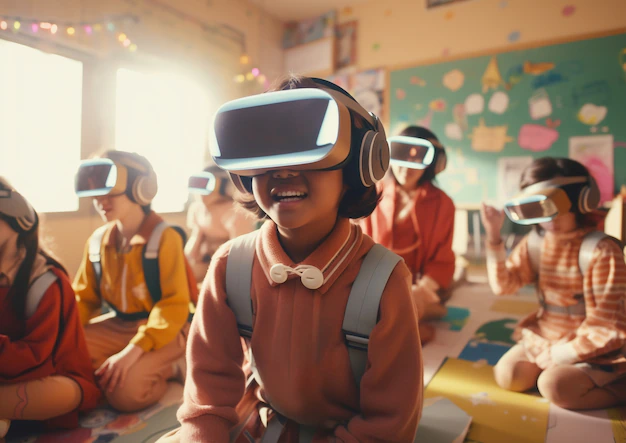In recent years, the landscape of education has undergone a remarkable transformation, with technology playing a pivotal role in reshaping traditional learning methods. One of the most revolutionary advancements in this realm is the integration of Virtual Reality (VR) into educational practices. This immersive technology has the potential to redefine the way students learn, engage, and collaborate.
In this exploration, we delve into the realms of virtual reality in education, highlighting its impact on community learning platforms and examining the nuances of distance learning versus online learning.
The Rise of Virtual Reality in Education
Virtual Reality, once relegated to the realm of gaming and entertainment, has found a profound application in the educational sphere. The ability of VR to create simulated environments that replicate real-world scenarios has unlocked new dimensions for learning. As students don VR headsets, they are transported to historical events, scientific laboratories, or even distant planets, providing an unparalleled level of immersion.
Educators and technologists alike recognize the potential of VR to enhance the educational experience. It caters to diverse learning styles, offering a multisensory and interactive approach that resonates with students. Traditional textbooks and two-dimensional images are replaced by three-dimensional simulations, fostering a deeper understanding of complex subjects. As technology continues to advance, the cost of VR equipment is gradually decreasing, making it more accessible to educational institutions.
Community Learning Platforms and Virtual Reality
The concept of community learning platforms has gained prominence in the context of virtual reality in education. These platforms leverage VR technology to create collaborative and interactive learning environments, transcending the limitations of physical classrooms. In a community learning platform, students from different geographical locations can come together in a shared virtual space.
Imagine a scenario where students from various parts of the world collaborate on a history project. Instead of reading about historical events, they step into a virtual reconstruction of ancient civilizations. This collaborative and immersive learning experience fosters a sense of global community and understanding. Community learning platforms powered by VR enable students to learn not only from their teachers but also from their peers, creating a dynamic and interconnected educational ecosystem.
Moreover, virtual reality enhances the social aspect of learning. Students can engage in virtual discussions, participate in group projects, and attend virtual events within the community learning platform. This not only cultivates a sense of belonging but also prepares students for the collaborative nature of the modern workforce, where remote teams are increasingly prevalent.
Distance Learning vs. Online Learning: Unpacking the Distinctions
The terms “distance learning” and “online learning” are often used interchangeably, but they represent distinct approaches to education, each with its own set of characteristics. Virtual reality introduces a new dimension to this conversation, offering an immersive layer that goes beyond the conventional online learning experience.
Distance Learning: Bridging Physical Gaps
Distance learning, as the name suggests, refers to the educational process where students and instructors are geographically separated. This approach predates the digital age and has traditionally relied on correspondence courses, mail-in assignments, and occasional on-site sessions. The primary goal of distance learning is to overcome the limitations of physical distance, allowing students to pursue education irrespective of their location.
The advent of technology has propelled distance learning into the online realm, with the internet serving as the primary medium for communication and content delivery. While distance learning may leverage online tools, it often lacks the interactive and immersive elements that characterize virtual reality. Students access course materials, submit assignments, and engage in discussions through online platforms, but the learning experience is predominantly two-dimensional.
Online Learning: The Digital Classroom
Online learning represents a more contemporary approach, leveraging the internet and digital technologies to deliver educational content. Unlike traditional distance learning, online learning often involves real-time interactions between students and instructors. Virtual classrooms, discussion forums, and multimedia content are common elements of online learning platforms.
The key distinction lies in the synchronous nature of online learning, where students and instructors engage in live interactions, replicating the dynamics of a physical classroom. However, online learning is still bound by the limitations of a flat, screen-based experience. It may lack the tangible and experiential elements that contribute to a deeper understanding of certain subjects.
Related: Leveraging Technology: The Rise Of Virtual And Hybrid Events

Virtual Reality in the Educational Mix
As virtual reality emerges as a powerful educational tool, it adds a new layer to the distance learning vs. online learning debate. Virtual reality in education combines the flexibility of distance learning with the interactive and immersive elements of online learning. Students engaged in virtual reality experiences can feel as if they are physically present in the same space, regardless of the actual distance between them.
In a virtual reality setting, students can participate in real-time collaborative projects, engage in hands-on simulations, and interact with 3D models. The technology has the potential to bridge the gap between distance and online learning, offering a more holistic and engaging educational experience. Virtual reality not only facilitates knowledge transfer but also creates an environment where students can apply what they learn in practical, real-world scenarios.
Challenges and Opportunities
While the integration of virtual reality in education opens up a world of possibilities, it is not without its challenges. One significant hurdle is the cost associated with implementing VR technology in educational institutions. VR headsets, software development, and maintenance require a substantial investment, making it difficult for some institutions to adopt this technology on a large scale. However, as the technology matures and becomes more mainstream, these costs are expected to decrease.
Another challenge is the need for specialized training for educators to effectively integrate virtual reality into their teaching methods. Educators must become familiar with VR tools, content creation, and the pedagogical principles that maximize the benefits of this technology. Professional development programs and ongoing support are crucial to ensure that teachers can harness the full potential of virtual reality in their classrooms.
On the flip side, the opportunities presented by virtual reality in education are immense. The technology has the potential to democratize access to high-quality education, especially for students in remote or underserved areas. Virtual reality can bring expert instructors and resources directly into the homes of students, breaking down geographical barriers and leveling the playing field.
Furthermore, virtual reality opens up new possibilities for personalized learning. By tailoring educational experiences to individual learning styles and preferences, VR can accommodate diverse student needs. For example, students who struggle with traditional learning methods may thrive in a virtual reality environment that provides a more interactive and experiential approach to education.
The Future Landscape of Education
As we navigate the evolving landscape of education, virtual reality stands as a transformative force that has the potential to redefine how we teach and learn. The integration of VR into community learning platforms creates a globalized and interconnected educational ecosystem, fostering collaboration and understanding among students from diverse backgrounds.
The distinctions between distance learning and online learning are becoming blurred with the infusion of virtual reality. The immersive nature of VR enhances the online learning experience, bringing a sense of presence and engagement that goes beyond the limitations of traditional distance education. As technology continues to advance and VR becomes more accessible, we can expect a paradigm shift in education, with virtual reality playing a central role in shaping the future of learning.
Conclusion
Exploring the world of virtual reality in education unveils a landscape rich with possibilities and challenges. The fusion of community learning platforms and virtual reality creates an environment where students can collaborate, learn, and engage in ways previously unimaginable. As we weigh the distinctions between distance learning and online learning, virtual reality emerges as a catalyst for innovation, offering a glimpse into the future of education—one where borders dissolve, collaboration knows no physical bounds, and learning becomes an immersive, shared experience.
Read Also:

















